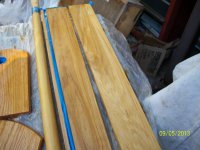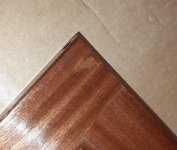Steve1
Member
I have been putting super blond shellac, 1.5 lb cut on sapele recently.
Finished quite a bit of sapale actually, just fine.
But when doing the doors recently, the shellac developed a "dry spot".
I keep putting more coats on the dry spot, but it looks as if I put nothing.
I searched it on the internet, and did not find much. A couple of suggestions that the shellac may have been overworked. That is certainly possible -- first coat 2.0 lb cut, went on too heavy (but no bald spots) and I rubbed out a few heavy spots.
Last night I cleaned the spot with alcohol, then this morning sanded it and put 2 coats of shellac on the spot. See photo below -- looks like I put nothing.
What happened here, and what is proper remedy ?
[attachimg=1]
Finished quite a bit of sapale actually, just fine.
But when doing the doors recently, the shellac developed a "dry spot".
I keep putting more coats on the dry spot, but it looks as if I put nothing.
I searched it on the internet, and did not find much. A couple of suggestions that the shellac may have been overworked. That is certainly possible -- first coat 2.0 lb cut, went on too heavy (but no bald spots) and I rubbed out a few heavy spots.
Last night I cleaned the spot with alcohol, then this morning sanded it and put 2 coats of shellac on the spot. See photo below -- looks like I put nothing.
What happened here, and what is proper remedy ?
[attachimg=1]



